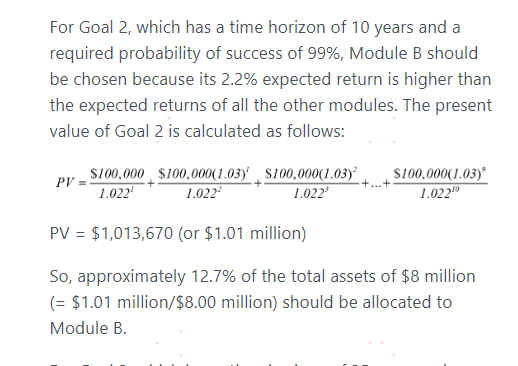NO.PZ202212280100004702
问题如下:
B. Construct the overall goals- based asset allocation for the Armstrongs
given their three goals and Abbott’s suggestion for investing any excess
capital. Show your calculations. (原版书)

选项:
解释:
• The module that should be selected for each goal is the one that offers the highest return given the time horizon and required probability of success.
• Approximately 16.4%, 12.7%, 50.4%, and 20.5% should be invested in Modules A, B, C, and D, respectively.
The appropriate goals- based allocation for the Armstrongs is as follows:

For Goal 1, which has a time horizon of five years and a required probability of success of 85%, Module C should be chosen because its 4.4% expected return is higher than the expected returns of all the other modules. The present value of Goal 1 is calculated as follows:
N = 5, FV = –5,000,000, I/Y = 4.4%; CPT PV = $4,031,508 (or $4.03 million)
So, approximately 50.4% of the total assets of $8 million (= $4.03 million/$8.00 million) should be allocated to Module C.
For Goal 2, which has a time horizon of 10 years and a required probability of success of 99%, Module B should be chosen because its 2.2% expected return is higher than the expected returns of all the other modules. The present value of Goal 2 is calculated as follows:
PV = $1,013,670 (or $1.01 million)
So, approximately 12.7% of the total assets of $8 million (= $1.01 million/$8.00 million) should be allocated to Module B.
For Goal 3, which has a time horizon of 25 years and a required probability of success of 75%, Module D should be chosen because its 7.5% expected return is higher than the expected returns of all the other modules. The present value of Goal 3 is calculated as follows:
N = 25, FV = –10,000,000, I/Y = 7.5%; CPT PV = $1,639,791 (or $1.64 million)
So, approximately 20.5% of the total assets of $8 million (= $1.64 million/$8.00 million) should be allocated to Module D.
Finally, the surplus of $1,315,032 (= $8,000,000 – $4,031,508 – $1,013,670 – $1,639,791), representing 16.4% (= $1.32 million/$8.00 million), should be invested in Module A following Abbott’s suggestion.
老师,关于module B的算法,能先假设begin PMT,再除1.022吗?我这么答能拿把分拿满吗?
For module B: PMT(begin) = 100000, real required rate of return = 1.022/1.03-1=-0.7767%, N =10, so PV =1035970.554, the amount should be PV/1.022 = 101367
For module C: 5/(1.044^5) = 4.03 million
For module D: 10/(1.075^25) =1.64 million
For module A: 8-1.044-4.03-1.64 = 1.29 million





